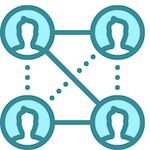A woman and her son were sitting near the side of a country road.
From a distance, the two saw a horse galloping down the road towards them.
Taking the horse’s speed into account, they assumed the rider had somewhere very important to go.
As the horse and rider flew by the boy and his mother, the boy shouted,
“Where are you going?”
The man on the horse shouted back, “I don’t know, ask the horse!”
Habits and patterns have an energy of their own, as suggested in this old Zen story.
As we ride into the new year, remember that we must not sit on the back of old habits and patterns.
There is nothing wrong with running after something; just be certain that you know why it is important to you.
Now saddle up and gallop off into your healthy, happy and prosperous 2021!
Regards,
Dan
“Relevant & pragmatic ideas, tools and insights to play at your best.”

For You
After leaving the holiday season behind (and the wonderful seasonal meals), few people want to think about more feasting. Yet before last year becomes too distant in our rear-view mirror, let me suggest that you feast on failure, as a reflection exercise.
Take some quiet time this week and write down the failures you experienced in the past year. Do not worry about who is to blame, or what could have happened if only this had gone a different way, just record what you considered a personal failure in the past year.
After you have your list of failures, place them in one of the following three columns:
| 1-Failed to start | 2-Started but failed to finish | 3-Started, completed, and failed
to get the desired results |
Chances are that when you review where you placed your failures, you will find most of them in the first column, that is “failed to start”, followed by “started but failed to finish”, with the least in column three.
Plato reminds us the that the beginning is the most important part of the work and Martin Luther King insisted that we do not have to see the whole staircase to take the first step.
If we are never failing, we are never learning, and failure is an essential component in the formula for success. Improvement and growth come from our experiences in column three, so be certain you do not sabotage your opportunities for growth because you did not get the car out of the driveway.
What frameworks or processes do you use to feast on your failures, individually and as a leadership team?

For You & Your Team
Are constraints causing you to cut back or create?
The Latin origin of constraint, contringere, meant to bind together, to tie tightly, shackle or chain something or someone. Today we use constraint to describe something that limits or restricts us from being able to act.
Some clients saw restricted business travel, few or no face-to-face customer meetings, home office isolation and simply the inability to meet as constraints that prevented them from achieving their goals. Yet others saw these constraints as an invitation to innovate, to enhance or adapt how they had previously operated to achieve and exceed their targets. Here are three examples:
- Client I – Reached all time high customer satisfaction levels by shifting world-wide travel to a more focused, virtual client support system, connecting, and improving customer experience points with systemic outcome measurement. The constraints of no physical travel led this global client to dedicate more competent resources in the virtual client support environment and involve others who previously had little contact to customers.
- Client II – Dramatic improvements in employee engagement results through innovative collaborations, personal support systems, and providing accurate and pragmatic COVID-19 guidelines aimed at employees and their providers. “We have never felt so appreciated”, one line manager commented.
- Client III – Improved employee well-being, resilience and identified internal resources to support those that were struggling through bottom up, grass roots resilience initiatives, all successfully conducted in an interactive, virtual environment.
Here are four steps to help you and your team innovate effectively through constraints:
- View constraints as a pivot point, rather than an obstacle or something that you are missing
- Develop an appreciative attitude towards constraints
- Embrace the constraint, rather than avoid it, and treat it as a springboard which helps you later adapt or overcome the challenge at hand
- Acknowledge and discuss the fear of failure that often prevents teams from making constructive progress with constraints
- Start small, address constraints through small experiments and smaller projects. There is no need to go big in the beginning, this can come later as your confidence and innovative results grow
How were you and your team sidelined, or inspired by constraints last year?

For You, Your Team & Your Business
When people complain about things that do not work in your business, do you get defensive and shut people down with your executive arguments?
There is no such thing as a business without problems. When people will not tell you the problems they are struggling with, then you have a problem. Highly effective leadership teams share their struggles, and this enables everyone to bring their expertise to the problems at hand.
An executive recently challenged my observations that their business strategy was not clear or compelling. (This feedback I gathered from strategic leaders across the organization.) This same executive blows up when someone shares what is not working, quickly signaling to everyone it is better not to “call out” problems.
When people cannot or will not share their struggles, the entire business struggles.
How well does your leadership team encourage others to share their struggle publicly, so you and others can provide the appropriate support for innovative solutions?
Take this question into your next leadership meeting and see where your strengths and blind spots are. If you are not getting a “problem rich discussion” in your leadership team, please let me know.
People, Places & Technology
Leadership Growth Lab & a New Year’s Learning Incentive…
While most of my work involves working with intact leaderships teams; more and more people are coming to me for individual coaching and looking for a high caliber, challenging peer group setting to accelerate their personal and business growth.
If you are interested in working closely with me and a small group of high performance peers who, like you, want to maximize their potential as a leader, one of my leadership growth labs could be of interest to you.
The Leadership Growth Lab is made up of five to six professionals, often coming from diverse companies and industries and who share a desire to accelerate their growth as a leader and results for their business.
None of us is as smart as all of us; you will grow faster—with fewer wrong turns and much more enjoyment—leveraging the insights you develop in the Leadership Growth Labs. Throughout your growth lab cycle, you will get personal advice, practice sessions and strategic business exchanges on topics that matter most for your leadership success. For more information about my leadership growth labs click the link, drop me a mail dn@dannorenberg.com or ring me at +49 172 862 5123.
When you join a growth lab before March 31, you’ll receive this program for 33 to 50% off the normal price, details in the link above. Happy New Year!
Thought for the Day
“Don’t coach the individual, coach the team.
There is too much focus on the individual player,
when the emphasis should be on the team.”
-José Mourinho
